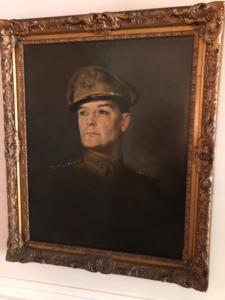
Having studied and written about Colonel Sidney Mashbir, it was my good fortune when Robert Warren and his son William Warren contacted me in 2018 to discuss their close friendship with Colonel Mashbir many years earlier.
William and Robert generously shared various historical materials linked to Colonel Mashbir (1891-1973). This blog post will present a number of those items, as well as Robert and William’s recollections of Colonel Mashbir. Also included is biographic material about Robert and William Warren, who being younger than Mashbir, were inspired and influenced by Colonel Mashbir’s heroic dedication to our nation.
-The oil painting illustration of General Douglas MacArthur shown above is courtesy of the William Warren.
Further details about the General MacArthur oil painting.
Below is an email sent by William (aka Bill) dated April 17, 2018, giving more info about the history of the painting and why it was gifted to him.
“Stan, here are photographs of the portrait of General MacArthur. I have provided three views, one where I stood back in order to give you an idea of the relative size of it.
According to Alice Mashbir, she thought that Sid would have wanted me to have this portrait as it was one of his most loved things. The portrait hung over his mantle at his house in Emerald Bay (Laguna Beach). Also according to Alice, Sid acquired this portrait from an art store in New York (City I think) and it was a big secret about what he may have paid for it. It was apparently commissioned by General MacArthur’s wife. The story goes that when she discovered an infidelity she threw champagne at the portrait. That may be true since one can clearly see very faint dribbles of something.
The artist of the portrait was Julian Lamar. I am not sure when it was painted. A bit about Julian Lamar:
Born Julian Kitchen Lamar Miller in Augusta, Georgia, he shortened his name to Lamar in 1922 to honor his mother’s family and to make his name more memorable as an artist. Although he began painting as a child, his family encouraged him to attend the United States Military Academy, from which he graduated in 1918. After the Armistice, he resigned his commission to concentrate on his career as an artist. Lamar lived for a while in Chicago, then moved to New York in 1920.
He maintained an active studio in New York, but traveled extensively to paint his subjects in their native surroundings. He painted many prominent figures, including Prime Minister Winston Churchill; President Franklin D. Roosevelt; Franklin H. Martin, President, American College of Surgeons; and Governor Frank Dixon, Alabama. He was also an accomplished landscape painter.
You can Google him…there is a lot of information about him on the web.
Enjoy Stan. I will forward documents this afternoon.
Bill Warren”
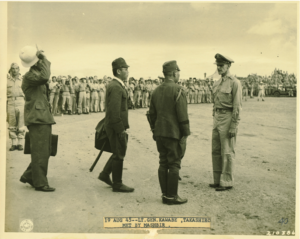
August 19, 1945, Lt. General Kawabe, Takashiro met by Mashbir. Source of photo: courtesy of William Warren.
Besides taking a decisive role in the winning of WWII, Colonel Mashbir also helped orchestrate the Japanese Surrender Signing Ceremony, officially ending the conflict. In the above photo, Mashbir receives the Japanese Surrender Signing Arrangement committee in Manila, Philippines. They would work together to organize the details for the surrender.
The term V-J Day represents both the initial announcement of Japan’s surrender on the afternoon of August 15, 1945 in Japan, and because of time zone differences, August 14, 1945 when it was announced in the United States and the rest of the Americas and Eastern Pacific Islands. V-J Day is also represented as September 2, 1945, when the actual signing of the surrender document occurred, officially ending World War II.
A Gift to Colonel Mashbir from General MacArthur
The Photo inscription reveals Mashbir’s significant role in winning World War Two.
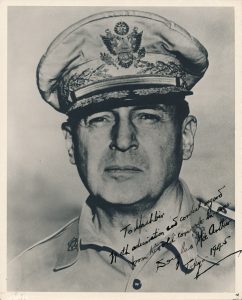
“To Mashbir”
“With admiration and cordial regard from his old comrade-in-arms.”
“Douglas MacArthur”
“Tokyo – 1945”
Twenty seven years later, in 1972, the below inscribed portrait photo of Colonel Mashbir was respectfully gifted to his good friend Robert Warren, who Mashbir addressed as:
“Colonel Bob Warren, a gallant Marine”.
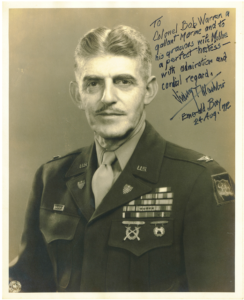
Robert’s son, William, has added the below description linked to this photo.
“Here is a photo of Sid with an inscription to my Dad and Mother (Millie). Mother passed away in January 2010, but she, my Dad, Sid and Alice became good friends over the years. This photo is dated 1972. There are two photos of my Dad that I thought you might like to have, one was his official USMC photo taken in 1969 I think and the other where he is posed on the jet was taken, I think, in 1965 (see below). He was then a Lt. Colonel and was the Commanding Officer of the Marine Attack Squadron, VMA-331 based in Beaufort, SC. The squadron flew the Douglas A-4 Skyhawk. A side note, one of the previous Commanding Officers of VMA-331 was Lt. Colonel Don Conroy who was the “Great Santini” character in Pat Conroy’s novel of the same name.”
______________________________
Presented below is further Information about Colonel Mashbir and other topics gathered during an interview with Colonel Robert F. Warren – May 18, 2018.
Colonel Robert F. Warren proudly mentioned that his son William had been an infantry platoon leader in Viet Nam, and that the survival rate for that position averaged only 4-6 months. Thank God he made it back.
Robert stated he spent many hours with Mashbir and recalled that Mashbir was angry with General Willoughby, who was General MacArthur’s chief of staff GHQ during WWII. Robert said that Mashbir would mockingly imitate Willoughby’s accent. Mashbir’s anger stemmed from his feeling that Willoughby had often prevented Mashbir from directly delivering urgent strategic information to MacArthur, and that Willoughby regularly took credit for many of Mashbir’s ideas.
Below are a number of other comments Colonel Warren made related to Colonel Mashbir.
-When Mashbir returned to the Imperial Hotel after surviving the Great Kanto Earthquake of 1923, the Hotel Manager Inmaru (sp?) responded as if, “He couldn’t be more surprised if he’d seen the Buddha step out of Hell.”
-Robert clarified a matter linked to the historical novel about Colonel Mashbir, titled The Emperor and the Spy. Robert said that Mashbir’s good friend James Moriarty (Marine) was sent to China first, then to Japan.
-Sidney Mashbir’s son Forrester (his older son) became the manager of entertainment at the Sands Hotel/Casino in Las Vegas.
-Robert met Don Mashbir (Sidney’s younger son) and Don’s wife Rosa.
-Sid told Don that Sid didn’t want heroics to keep him alive when he got near the end.
-Sidney Mashbir’s home was in Emerald Bay, in Laguna Beach, which has beautiful views.
-Sid came to Robert’s military retirement party.
-Sid started the Pan-Pacific Club of Tokyo. Robert said, “Sid had a strong positive feeling for the whole nation of Japan.”
-Robert stated, “Sid had respect for the top levels of the Japanese hierarchy who were against war; they were almost prisoners of the military or they were eliminated altogether.”
-When Mashbir was leaving Japan, he laid on the floor of the ship, so as not to see Mt. Fuji, because he was superstitious that if you do not wish to return to Japan, you should not look back at that magnificent mountain view.
William Warren wrote the below letter:
“I have just ordered two copies of your book [The Emperor and the Spy], one for my father and one for myself. Both of us had the pleasure of calling Colonel Mashbir our friend. I personally spent many, many hours with Colonel Mashbir at his home in Laguna Beach. He and his second wife, Alice were host to me on many, many weekends when I was a young Lieutenant in the US Marine Corps. Sid also invited me to the Army and Navy Club in Washington DC where I believe he was a charter member. He was a most amazing man and one of my all-time heroes!! After Sid’s death, Alice sent me the original oil painting of General MacArthur that was one of his prized possessions. This portrait hung over the mantel in his Laguna Beach home. Alice told me that Sid would have wanted me to have this portrait and that I was to forever keep this in my family, never giving it to a museum or selling it. That portrait still hangs in my home today. Alice also gave me a copy of Sid’s book, “I was an American Spy” and she endorsed the book for me.
I have not yet read your book, but would love to keep in touch with you. Thank you for honoring this great man.
(William) Bill Warren, 9026 Mossy Hill Lane, Indian Land, SC 29707.”
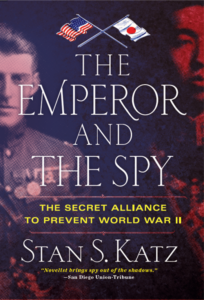
Presented below are William Warren’s comments after reading this novel:
“Review of “The Emperor and the Spy”
“A true story of intrigue, history and a little known American hero.”
By Bill Warren on May 27, 2018
“I had the good fortune to have met Colonel Sidney Mashbir when I was a newly minted Lieutenant in the Marine Corps. It was my distinct honor to have spent hours and hours with him over the years, visiting him both in his home in Laguna Beach, California and at the Army and Navy Club in Washington, DC where he enjoyed the status as a charter member. During those visits, Colonel Mashbir related hundreds of stories and showed me untold number of documents and I think I spent hundreds of hours listening to him. I am not sure what cemented the relationship I had with this fascinating hero, but I treasured every moment and consider him to have been among my very best friends, mentor and teacher. I am both in awe of and pleased with Stan S. Katz who recognized a real hero of our country and that he undertook the mission to write this book. His research for The Emperor and the Spy, appears to be meticulous and he tells a story that NEEDS to be told. Not many would ever have guessed that Colonel Mashbir served with General Pershing in Mexico. Likewise, who would have believed that Colonel Mashbir would have become so endeared with, respected by and maintained a secret alliance with the royal family of Japan prior to World War II. The Colonel indeed had a special relationship with Prince Tokugawa, the Emperor Hirohito and their families. Through these relationships, Colonel Mashbir made a valiant attempt to avert WWII in the Pacific. That is just part of the story. The other part is the intelligence work performed for General Douglas MacArthur during the war that, without a doubt, shortened the war with Japan. Even after the war, Colonel Mashbir utilized his deep understanding of the Japanese and his friendship with many of its leaders to make major contributions to the peaceful occupation of Japan and without those efforts, the outcome of post-war Japan would have been a completely different country.
Stan Katz skillfully weaves this story into a very readable and exciting historical fictionalized novel. His facts, based on the stories told to me by Colonel Mashbir are genuine and because of the nature of Colonel’s work, are irrefutable. Stan easily stands with Bernard Cornwell, Jeff Sharra and Michael Sharra in his skill constructing a superb story around historical facts and with Brad Meltzer in his ability to develop historical characters while keeping the adventure exciting. If you like historical novels and want to learn about a real American hero, you will find it in this magnificent book.” Note: On May 13th, 2018, Bill Warren called his father Robert and related, “That his Dad had read the first half of The Emperor and the Spy, and was thoroughly enjoying it.”
Another Interview with William Warren linked to Colonel Mashbir.
William described Sidney Mashbir as the consummate gentlemen. Rarely, if ever, did he hear him raise his voice. William commented that I had captured the essence of the man in The Emperor and the Spy, and that he thought Sidney and I would have gotten along well, which made my day.
William confirmed what his father Robert had told him, that during WWII, Mashbir hated General Willoughby and they had numerous confrontations/tussles. William felt that Willoughby outranked Mashbir and Mashbir had to take it. “Mashbir couldn’t stand the man.” William said, “Willoughby might have blocked Mashbir from getting directly to General MacArthur, but Mashbir probably violated the chain of command to get to General MacArthur on occasion.”
William stated I got the story right in the novel, that when recruiting the Nisei for the WWII intelligence organization ATIS, it helped that they could both speak and read the language. Speaking Japanese is relatively easy, but reading it is much more difficult.
William said he thought that MacArthur felt somewhat abandoned in the Pacific theater, with most of the military resources going to the European theater of war.
THESE BOOKS OFFER FURTHER INSIGHTS INTO THE FASCINATING AND EXCITING EXPLOITS OF COLONEL MASHBIR.

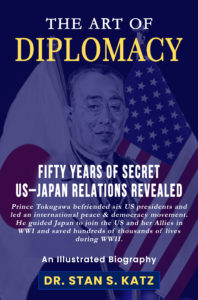
This biography highlights one of Colonel Mashbir’s most influential Japanese allies, Prince Tokugawa Iesato.
During the 1920s and ’30s, Mashbir and Tokugawa heroically strove to maintain the goodwill between their nations.
Available in Print and Kindle EBook
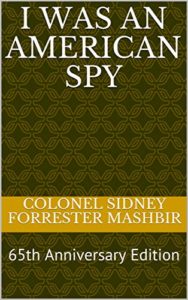
EBOOK REPUBLICATION OF COLONEL MASHBIR’S 1953 AUTOBIOGRAPHY
PARTING NOTE:
It was a pleasure meeting Robert and William Warren, two impressive gentlemen who proudly served our nation.
Colonel Robert F. Warren wrote a screenplay, and in association with U.S. military historian and writer, Navy Lt. Charles Wyatt, they completed an adaptation of that screenplay into a short novel titled: The Elephants of Trabong – This dramatic and engaging story is linked to Robert’s experiences during the Viet Nam War, where his assignment was to win the hearts and minds of the Vietnamese citizenry thru improving the economic life in their villages. It would definitely make a great movie!
*Representatives of the film industry can receive a synopsis of the screenplay and novel thru the below contacts:
William Warren: bill@war97.com
Colonel Robert F. Warren also wrote an autobiography on his personal life story & military experiences in three wars.
Blog link on the website for more information about Colonel Warren and his autobiography “ONLY IN MY AMERICA”.


 Tony Fisher says
Tony Fisher says
April 15, 2020 at 4:04 pmHi Bob…
Stan S. Katz probably told you that I was also a friend of Col. Mashbir. During the summer months (June, July, & August) our house was directly across the street from Col. Mashbir’s house. I found your remembrances about General MacArthur’s portrait which hung over the mantel of his fireplace interesting, because…prior to MacArthur’s oil painting, his deceased wife’s oil painting of herself was above the mantle and each week Col. Mashbir would place one dozen long stem red roses next to his wife’s oil painting…after her passing, General MacArthur reigned over the fireplace mantel. I enjoyed reading about your friendship with Sidney Mashbir. He was a great man.
Best wishes,
Tony Fisher